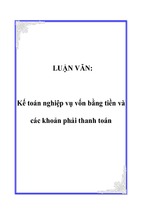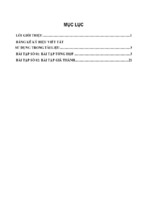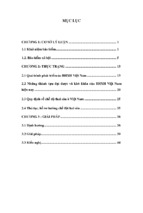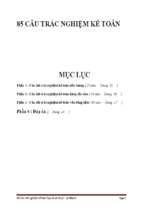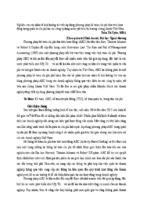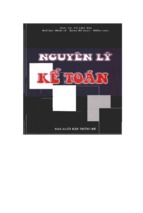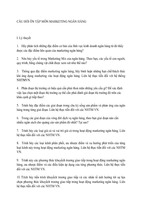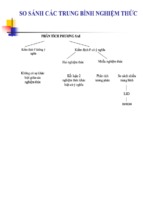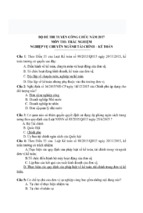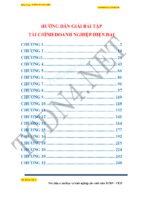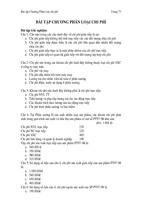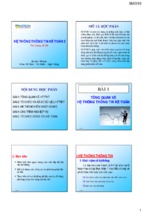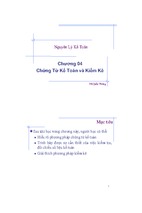Accounting
Information
Systems
SEVENTH EDITION
JAMES A. HALL
Peter E. Bennett Chair in
Business and Economics
Lehigh University
http://avaxhome.ws/blogs/ChrisRedfield
Accounting Information Systems,
Seventh Edition
James A. Hall
VP/Editorial Director: Jack W. Calhoun
Editor-in-Chief: Rob Dewey
Sr. Acquisitions Editor: Matt Filimonov
Editorial Assistant: Lauren Athmer
ª 2011, 2008 Cengage Learning
ALL RIGHTS RESERVED. No part of this work covered by the copyright herein may be reproduced, transmitted, stored or used in any form
or by any means graphic, electronic, or mechanical, including but not
limited to photocopying, recording, scanning, digitizing, taping, Web
distribution, information networks, or information storage and retrieval
systems, except as permitted under Section 107 or 108 of the 1976
United States Copyright Act, without the prior written permission of the
publisher.
Developmental Editor: Maggie Kubale
Marketing Manager: Natalie King
Marketing Coordinator: Heather McAuliffe
Associate Content Project Manager: Jana Lewis
Manager of Technology, Editorial: Matt McKinney
For more information about our products, contact us at:
Cengage Learning Academic Resource Center,
1-800-423-0563
For permission to use material from this text or product, submit a
request online at http://www.cengage.com/permissions.
Media Editor: Bryan England
Sr. Manufacturing Buyer: Doug Wilke
Production Technology Analyst: Starratt Alexander
Production House: Cadmus Communications
Printer: Edwards Brothers
South-Western Cengage Learning, a part of Cengage Learning.
Cengage, the Star logo, and South-Western are trademarks used
herein under license.
Art Director: Stacy Jenkins-Shirley
Library of Congress Control Number: 2009938064
Marketing Communications Manager: Libby Shipp
ISBN-13: 978-1-4390-7857-0
Permissions Acquisition Manager: Roberta Broyer
ISBN-10: 1-4390-7857-2
Cover Designer: Itzhack Shelomi
Cover Image: iStock Photo
Printed in the United States of America
1 2 3 4 5 13 12 11 10 09
Cengage Learning
5191 Natorp Boulevard
Mason, OH 45040
USA
Brief Contents
Preface xvii
Part I
Overview of Accounting Information
Systems 1
Chapter 1
The Information System: An
Accountant’s Perspective 3
Chapter 2
Introduction to Transaction
Processing 41
Chapter 3
Ethics, Fraud, and Internal Control 111
Part II
Transaction Cycles and Business
Processes 151
Chapter 4
The Revenue Cycle 153
Chapter 5
The Expenditure Cycle Part I:
Purchases and Cash Disbursements
Procedures 217
Chapter 6
The Expenditure Cycle Part II: Payroll
Processing and Fixed Asset
Procedures 265
Chapter 7
The Conversion Cycle 305
Chapter 8
Financial Reporting and Management
Reporting Systems 349
Part III
Chapter 9
Advanced Technologies in Accounting
Information 395
Database Management Systems 397
Chapter 10
The REA Approach to Database
Modeling 459
Chapter 11
Enterprise Resource Planning Systems
489
Chapter 12
Electronic Commerce Systems 523
iii
iv
Brief Contents
Part IV
Systems Development Activities 571
Chapter 13
Managing the Systems Development
Life Cycle 573
Chapter 14
Construct, Deliver, and Maintain
Systems Project 605
Part V
Computer Controls and Auditing 663
Chapter 15
IT Controls Part I: Sarbanes-Oxley
and IT Governance 665
Chapter 16
IT Controls Part II: Security and
Access 703
Chapter 17
IT Controls Part III: Systems
Development, Program Changes, and
Application Controls 737
Glossary
773
Index
791
Contents
Preface xvii
Acknowledgments xxvi
Dedication xxvii
Part I
Chapter 1
Overview of Accounting Information
Systems 1
The Information System: An Accountant’s
Perspective 3
THE INFORMATION ENVIRONMENT 4
What Is a System? 5
An Information Systems Framework 7
AIS Subsystems 9
A General Model for AIS 10
Acquisition of Information Systems 14
ORGANIZATIONAL STRUCTURE 15
Business Segments 15
Functional Segmentation 16
The Accounting Function 19
The Information Technology Function 20
THE EVOLUTION OF INFORMATION SYSTEM MODELS 24
The Manual Process Model 24
The Flat-File Model 25
The Database Model 27
The REA Model 28
Enterprise Resource Planning Systems 31
THE ROLE OF THE ACCOUNTANT 31
Accountants as Users 32
Accountants as System Designers 32
Accountants as System Auditors 32
SUMMARY 33
Chapter 2
Introduction to Transaction Processing 41
AN OVERVIEW OF TRANSACTION PROCESSING 42
Transaction Cycles 42
ACCOUNTING RECORDS 44
Manual Systems 44
The Audit Trail 50
v
vi
Contents
Computer-Based Systems 51
DOCUMENTATION TECHNIQUES 53
Data Flow Diagrams and Entity Relationship Diagrams 53
System Flowcharts 57
Program Flowcharts 64
Record Layout Diagrams 67
COMPUTER-BASED ACCOUNTING SYSTEMS 67
Differences between Batch and Real-Time Systems 68
Alternative Data Processing Approaches 69
Batch Processing Using Real-Time Data Collection 71
Real-Time Processing 74
DATA CODING SCHEMES 74
A System without Codes 74
A System with Codes 76
Numeric and Alphabetic Coding Schemes 76
SUMMARY 79
APPENDIX 80
Chapter 3
Ethics, Fraud, and Internal Control 111
ETHICAL ISSUES IN BUSINESS 112
Business Ethics 112
Computer Ethics 112
Sarbanes-Oxley Act and Ethical Issues 116
FRAUD AND ACCOUNTANTS 117
Definitions of Fraud 117
The Fraud Triangle 118
Financial Losses from Fraud 119
The Perpetrators of Frauds 120
Fraud Schemes 122
INTERNAL CONTROL CONCEPTS AND TECHNIQUES 128
SAS 78/COSO Internal Control Framework 132
SUMMARY 137
Part II
Chapter 4
Transaction Cycles and Business Processes
151
The Revenue Cycle 153
THE CONCEPTUAL SYSTEM 154
Overview of Revenue Cycle Activities 154
Sales Return Procedures 160
Cash Receipts Procedures 163
Contents
Revenue Cycle Controls 166
PHYSICAL SYSTEMS 170
MANUAL SYSTEMS 171
Sales Order Processing 171
Sales Return Procedures 174
Cash Receipts Procedures 174
COMPUTER-BASED ACCOUNTING SYSTEMS 177
Automating Sales Order Processing with Batch Technology 177
Keystroke 178
Edit Run 180
Update Procedures 180
Reengineering Sales Order Processing with Real-Time
Technology 180
Transaction Processing Procedures 180
General Ledger Update Procedures 182
Advantages of Real-Time Processing 183
Automated Cash Receipts Procedures 183
Reengineered Cash Receipts Procedures 185
Point-of-Sale (POS) Systems 185
Daily Procedures 185
End-of-Day Procedures 187
Reengineering Using EDI 187
Reengineering Using the Internet 188
Control Considerations for Computer-Based Systems 188
PC-BASED ACCOUNTING SYSTEMS 190
PC Control Issues 190
SUMMARY 191
APPENDIX 192
Chapter 5
The Expenditure Cycle Part I: Purchases and
Cash Disbursements Procedures 217
THE CONCEPTUAL SYSTEM 218
Overview of Purchases and Cash Disbursements Activities 218
The Cash Disbursements Systems 225
Expenditure Cycle Controls 228
PHYSICAL SYSTEMS 230
A Manual System 230
The Cash Disbursements Systems 232
COMPUTER-BASED PURCHASES AND CASH
DISBURSEMENTS APPLICATIONS 234
Automating Purchases Procedures Using Batch Processing
Technology 234
vii
viii
Contents
Cash Disbursements Procedures 239
Reengineering the Purchases/Cash Disbursements System 240
Control Implications 242
SUMMARY 243
Chapter 6
The Expenditure Cycle Part II: Payroll
Processing and Fixed Asset Procedures 265
THE CONCEPTUAL PAYROLL SYSTEM 266
Payroll Controls 274
THE PHYSICAL PAYROLL SYSTEM 275
Manual Payroll System 275
COMPUTER-BASED PAYROLL SYSTEMS 277
Automating the Payroll System Using Batch Processing 277
Reengineering the Payroll System 279
THE CONCEPTUAL FIXED ASSET SYSTEM 281
The Logic of a Fixed Asset System 281
THE PHYSICAL FIXED ASSET SYSTEM 283
Computer-Based Fixed Asset System 283
Controlling the Fixed Asset System 286
SUMMARY 288
Chapter 7
The Conversion Cycle 305
THE TRADITIONAL MANUFACTURING
ENVIRONMENT 306
Batch Processing System 307
Controls in the Traditional Environment 318
WORLD-CLASS COMPANIES AND LEAN
MANUFACTURING 320
What Is a World-Class Company? 320
Principles of Lean Manufacturing 320
TECHNIQUES AND TECHNOLOGIES THAT PROMOTE LEAN
MANUFACTURING 322
Physical Reorganization of the Production Facilities 322
Automation of the Manufacturing Process 323
ACCOUNTING IN A LEAN MANUFACTURING
ENVIRONMENT 326
What’s Wrong with Traditional Accounting Information? 326
Activity-Based Costing (ABC) 328
Value Stream Accounting 329
INFORMATION SYSTEMS THAT SUPPORT LEAN
MANUFACTURING 331
Materials Requirement Planning (MRP) 331
Contents
Manufacturing Resource Planning (MRP II) 331
Enterprise Resource Planning (ERP) Systems 333
SUMMARY 334
Chapter 8
Financial Reporting and Management
Reporting Systems 349
THE GENERAL LEDGER SYSTEM 349
The Journal Voucher 350
The GLS Database 350
GLS Procedures 352
THE FINANCIAL REPORTING SYSTEM 352
Sophisticated Users with Homogeneous Information Needs 352
Financial Reporting Procedures 352
XBRL—REENGINEERING FINANCIAL REPORTING 355
XML 355
XBRL 356
The Current State of XBRL Reporting 361
CONTROLLING THE FRS 362
SAS 78/COSO Control Issues 362
Internal Control Implications of XBRL 364
THE MANAGEMENT REPORTING SYSTEM 365
FACTORS THAT INFLUENCE THE MRS 365
Management Principles 365
Management Function, Level, and Decision Type 368
Problem Structure 370
Types of Management Reports 371
Responsibility Accounting 374
Behavioral Considerations 378
SUMMARY 380
Part III
Chapter 9
Advanced Technologies in Accounting
Information 395
Database Management Systems 397
OVERVIEW OF THE FLAT-FILE VERSUS DATABASE
APPROACH 398
Data Storage 398
Data Updating 398
Currency of Information 399
Task-Data Dependency 399
The Database Approach 399
Flat-File Problems Solved 400
ix
x
Contents
Controlling Access to the Database 400
The Database Management System 400
Three Conceptual Models 401
ELEMENTS OF THE DATABASE ENVIRONMENT 401
Users 401
Database Management System 401
Database Administrator 404
The Physical Database 407
THE RELATIONAL DATABASE MODEL 407
Relational Database Concepts 408
Anomalies, Structural Dependencies, and Data Normalization 412
DESIGNING RELATIONAL DATABASES 419
Identify Entities 419
Construct a Data Model Showing Entity Associations 421
Add Primary Keys and Attributes to the Model 422
Normalize Data Model and Add Foreign Keys 422
Construct the Physical Database 423
Prepare the User Views 424
Global View Integration 427
DATABASES IN A DISTRIBUTED ENVIRONMENT 427
Centralized Databases 428
Distributed Databases 429
SUMMARY 433
APPENDIX 433
Chapter 10
The REA Approach to Database
Modeling 459
THE REA APPROACH 460
The REA Model 460
DEVELOPING AN REA MODEL 462
Differences between ER and REA Diagrams 463
View Modeling: Creating an Individual REA Diagram 463
VIEW INTEGRATION: CREATING AN
ENTERPRISE-WIDE REA MODEL 470
Step 1. Consolidate the Individual Models 470
Step 2. Define Primary Keys, Foreign Keys, and Attributes 475
Step 3. Construct Physical Database and Produce User Views 477
REA and Value Chain Analysis 481
REA Compromises in Practice 482
SUMMARY 482
Contents
Chapter 11
Enterprise Resource Planning Systems 489
WHAT IS AN ERP? 490
ERP Core Applications 491
Online Analytical Processing 492
ERP SYSTEM CONFIGURATIONS 492
Server Configurations 492
OLTP Versus OLAP Servers 493
Database Configuration 496
Bolt-on Software 496
DATA WAREHOUSING 497
Modeling Data for the Data Warehouse 497
Extracting Data from Operational Databases 498
Cleansing Extracted Data 498
Transforming Data into the Warehouse Model 500
Loading the Data into the Data Warehouse Database 501
Decisions Supported by the Data Warehouse 501
Supporting Supply Chain Decisions from the Data Warehouse 502
RISKS ASSOCIATED WITH ERP IMPLEMENTATION 503
Big Bang Versus Phased-in Implementation 503
Opposition to Changes in the Business’s Culture 504
Choosing the Wrong ERP 504
Choosing the Wrong Consultant 505
High Cost and Cost Overruns 506
Disruptions to Operations 507
IMPLICATIONS FOR INTERNAL CONTROL
AND AUDITING 507
Transaction Authorization 507
Segregation of Duties 508
Supervision 508
Accounting Records 508
Independent Verification 508
Access Controls 509
Internal Control Issues Related to ERP Roles 509
Contingency Planning 511
SUMMARY 512
APPENDIX 512
Chapter 12
Electronic Commerce Systems 523
INTRAORGANIZATIONAL NETWORKS AND EDI 524
INTERNET COMMERCE 524
Internet Technologies 524
xi
xii
Contents
Protocols 527
Internet Protocols 528
Benefits from Internet Commerce 530
RISKS ASSOCIATED WITH ELECTRONIC COMMERCE 532
Intranet Risks 532
Internet Risks 533
Risks to Consumers 533
SECURITY, ASSURANCE, AND TRUST 539
Encryption 539
Digital Authentication 540
Firewalls 542
Seals of Assurance 542
IMPLICATIONS FOR THE ACCOUNTING PROFESSION 543
Privacy Violation 543
Continuous Auditing 544
Electronic Audit Trails 545
Confidentiality of Data 545
Authentication 545
Nonrepudiation 545
Data Integrity 545
Access Controls 545
A Changing Legal Environment 546
SUMMARY 546
APPENDIX 546
Part IV
Chapter 13
Systems Development Activities 571
Managing the Systems Development Life
Cycle 573
THE SYSTEMS DEVELOPMENT LIFE CYCLE 574
Participants in Systems Development 575
SYSTEMS STRATEGY 576
ASSESS STRATEGIC INFORMATION NEEDS 576
Strategic Business Needs 576
Legacy Systems 577
User Feedback 577
DEVELOP A STRATEGIC SYSTEMS PLAN 580
CREATE AN ACTION PLAN 580
The Learning and Growth Perspective 581
The Internal Business Process Perspective 582
Contents
The Customer Perspective 582
The Financial Perspective 582
Balanced Scorecard Applied to IT Projects 582
PROJECT INITIATION 583
SYSTEMS ANALYSIS 583
The Survey Step 583
The Analysis Step 586
CONCEPTUALIZATION OF ALTERNATIVE DESIGNS 587
How Much Design Detail Is Needed? 587
SYSTEMS EVALUATION AND SELECTION 589
Perform a Detailed Feasibility Study 589
Perform Cost-Benefit Analysis 590
Prepare Systems Selection Report 595
Announcing the New System Project 596
User Feedback 597
THE ACCOUNTANT’S ROLE IN MANAGING THE SDLC 597
How Are Accountants Involved with SDLC? 597
The Accountant’s Role in Systems Strategy 598
The Accountant’s Role in Conceptual Design 598
The Accountant’s Role in Systems Selection 598
SUMMARY 598
Chapter 14
Construct, Deliver, and Maintain Systems
Project 605
IN-HOUSE SYSTEMS DEVELOPMENT 606
Tools for Improving Systems Development 606
CONSTRUCT THE SYSTEM 610
The Structured Design Approach 610
The Object-Oriented Design Approach 610
System Design 615
Data Modeling, Conceptual Views, and Normalized Tables 615
Design Physical User Views 615
Design the System Process 622
Design System Controls 625
Perform a System Design Walk-Through 625
Program Application Software 626
Software Testing 627
DELIVER THE SYSTEM 628
Testing the Entire System 628
Documenting the System 628
Converting the Databases 630
Converting to the New System 630
xiii
xiv
Contents
Postimplementation Review 631
The Role of Accountants 633
COMMERCIAL PACKAGES 633
TRENDS IN COMMERCIAL PACKAGES 633
Advantages of Commercial Packages 635
Disadvantages of Commercial Packages 635
CHOOSING A PACKAGE 635
MAINTENANCE AND SUPPORT 639
User Support 639
Knowledge Management and Group Memory 639
SUMMARY 640
APPENDIX 640
Part V
Chapter 15
Computer Controls and Auditing 663
IT Controls Part I: Sarbanes-Oxley
and IT Governance 665
OVERVIEW OF SOX SECTIONS 302 AND 404 666
Relationship between IT Controls and Financial Reporting 666
Audit Implications of Sections 302 and 404 667
IT GOVERNANCE CONTROLS 671
ORGANIZATIONAL STRUCTURE CONTROLS 671
Segregation of Duties within the Centralized Firm 672
The Distributed Model 674
Creating a Corporate IT Function 675
Audit Objectives Relating to Organizational Structure 676
Audit Procedures Relating to Organizational Structure 676
COMPUTER CENTER SECURITY AND CONTROLS 677
Computer Center Controls 677
DISASTER RECOVERY PLANNING 679
Providing Second-Site Backup 680
Identifying Critical Applications 681
Performing Backup and Off-Site Storage Procedures 681
Creating a Disaster Recovery Team 682
Testing the DRP 683
Audit Objective: Assessing Disaster Recovery Planning 683
Audit Procedures for Assessing Disaster Recovery Planning 683
OUTSOURCING THE IT FUNCTION 683
Risks Inherent to IT Outsourcing 684
Audit Implications of IT Outsourcing 685
SUMMARY 687
APPENDIX 687
Contents
Chapter 16
IT Controls Part II: Security and Access 703
CONTROLLING THE OPERATING SYSTEM 704
Operating System Objectives 704
Operating System Security 704
Threats to Operating System Integrity 705
Operating System Controls and Test of Controls 705
CONTROLLING DATABASE MANAGEMENT SYSTEMS 710
Access Controls 710
Backup Controls 712
CONTROLLING NETWORKS 713
Controlling Risks from Subversive Threats 713
Controlling Risks from Equipment Failure 721
ELECTRONIC DATA INTERCHANGE (EDI) CONTROLS 722
Transaction Authorization and Validation 723
Access Control 724
EDI Audit Trail 724
SUMMARY 726
APPENDIX 726
Chapter 17
IT Controls Part III: Systems Development,
Program Changes, and Application Controls
737
SYSTEMS DEVELOPMENT CONTROLS 738
Controlling Systems Development Activities 738
Controlling Program Change Activities 740
Source Program Library Controls 740
The Worst-Case Situation: No Controls 741
A Controlled SPL Environment 741
APPLICATION CONTROLS 745
Input Controls 745
Processing Controls 747
Output Controls 750
TESTING COMPUTER APPLICATION CONTROLS 752
Black Box Approach 753
White Box Approach 753
White Box Testing Techniques 756
The Integrated Test Facility 759
Parallel Simulation 760
SUBSTANTIVE TESTING TECHNIQUES 761
The Embedded Audit Module 761
Generalized Audit Software 763
SUMMARY 766
xv
This page intentionally left blank
Preface
Welcome to the Seventh Edition
T
he seventh edition of Accounting Information Systems includes a full range of
new and revised homework assignments and up-to-date content changes, as
well as several reorganized chapters. All of these changes add up to more student and instructor enhancements than ever before. As this preface makes clear, we
have made these changes to keep students and instructors as current as possible on
issues such as business processes, systems development methods, IT governance and
strategy, security, internal controls, and relevant aspects of Sarbanes-Oxley legislation.
Focus and Flexibility in Designing
Your AIS Course
Among accounting courses, accounting information systems (AIS) courses tend to be
the least standardized. Often the objectives, background, and orientation of the instructor, rather than adherence to a standard body of knowledge, determines the direction
the AIS course takes. Therefore, we have designed this text for maximum flexibility:
•
•
•
•
•
This textbook covers a full range of AIS topics to provide instructors with flexibility in setting the direction and intensity of their courses.
At the same time, for those who desire a structured model, the first nine chapters
of the text, along with the chapters on electronic commerce and computer controls,
provide what has proven to be a successful template for developing an AIS
course.
Earlier editions of this book have been used successfully in introductory,
advanced, and graduate-level AIS courses.
The topics in this book are presented from the perspective of the managers’
and accountants’ AIS-related responsibilities under the Sarbanes-Oxley Act.
Although this book was written primarily to meet the needs of accounting majors
about to enter the modern business world, we have also developed it to be an effective text for general business and industrial engineering students who seek a
thorough understanding of AIS and internal control issues as part of their
professional education.
Key Features
CONCEPTUAL FRAMEWORK
This book employs a conceptual framework to emphasize the professional and legal
responsibility of accountants, auditors, and management for the design, operation, and
control of AIS applications. This responsibility pertains to business events that are narrowly defined as financial transactions. Systems that process nonfinancial transactions
are not subject to the standards of internal control under Sarbanes-Oxley legislation.
Supporting the information needs of all users in a modern organization, however,
requires systems that integrate both accounting and nonaccounting functions. While
xvii
xviii
Preface
providing the organization with unquestioned benefit, a potential consequence of such
integration is a loss of control due to the blurring of the lines that traditionally separate
AIS from non-AIS functions. The conceptual framework presented in this book distinguishes AIS applications that are legally subject to specific internal control
standards.
EVOLUTIONARY APPROACH
Over the years, accounting information systems have been represented by a number of
different approaches or models. Each new model evolved because of the shortcomings
and limitations of its predecessor. An interesting feature in this evolution is that older
models are not immediately replaced by the newest technique. Thus, at any point in
time, various generations of legacy systems exist across different organizations and often coexist within a single enterprise. Modern accountants need to be familiar with the
operational characteristics of all AIS approaches that they are likely to encounter.
Therefore, this book presents the salient aspects of five models that relate to both
legacy and state-of-the-art systems:
1.
2.
3.
4.
5.
manual processes
flat-file systems
the database approach
the resources, events, and agents (REA) model
enterprise resource planning (ERP) systems
EMPHASIS ON INTERNAL CONTROLS
The book presents a conceptual model for internal control based on Statement on
Auditing Standards no. 78 (SAS 78) and the Committee of Sponsoring Organizations
of the Treadway Commission (COSO) frameworks. This SAS 78/COSO model is used
to discuss control issues for both manual processes and computer-based information
systems (CBIS). Three chapters (Chapters 15, 16 and 17) are devoted to the control of
CBIS. Special emphasis is given to the following areas:
•
•
•
•
•
•
•
•
•
computer operating systems
database management systems
electronic data interchange (EDI)
electronic commerce systems
ERP systems
systems development and program change processes
the organization of the computer function
the security of data processing centers
verifying computer application integrity
EXPOSURE TO SYSTEMS DESIGN AND
DOCUMENTATION TOOLS
This book examines various approaches and methodologies used in systems analysis
and design, including:
•
•
•
•
structured design
object-oriented design
computer-aided software engineering (CASE)
prototyping
Preface
In conjunction with these general approaches, professional systems analysts and programmers use a number of documentation techniques to specify the key features of systems. The modern auditor works closely with systems professionals during IT audits
and must learn to communicate in their language. The book deals extensively with
documentation techniques such as data flow diagrams (DFDs) and entity relationship diagrams (ERDs), as well as system and program flowcharts. It contains
numerous systems design and documentation cases and assignments intended to
develop students’ competency with these tools.
Significant Changes in the Seventh Edition
Chapter 2, ‘‘Introduction to Transaction Processing’’
This chapter has been updated to include a discussion of data coding schemes and their
role in transaction processing and AIS as a means of coordinating and managing a
firm’s transactions. The chapter presents the advantages and disadvantages of the major
types of numeric and alphabetic coding schemes. In the sixth edition, this material was
included in Chapter 8; it was moved in this edition because of its relevance as an element of transaction processing.
Chapter 3, ‘‘Ethic, Fraud, and Internal Control’’
This chapter has been revised to include the most recent research results published by
the Association of Certified Fraud Examiners (ACFE). The ACFE study provides estimates of losses due to fraud, categorizes fraud by various factors, and creates a profile
of fraud perpetrators. In addition, the chapter presents an expanded discussion of common fraud schemes.
Chapter 4, ‘‘The Revenue Cycle’’; Chapter 5 ‘‘The Expenditure Cycle Part I:
Purchases and Cash Disbursements Procedures’’; Chapter 6, ‘‘The Expenditure Cycle
Part II: Payroll Processing and Fixed Asset Procedures’’
The end-of-chapter material for these chapters has been significantly revised. This
entailed revising all the end-of-chapter internal control cases and creating several new
ones, In particular, great attention was given to internal control case solutions to ensure
consistency in appearance and an accurate reflection of the cases in the text. In the seventh edition, all case solution flowcharts are numerically coded and cross-referenced to
text that explains the internal control issues. This approach, which has been classroom
tested, facilitates effective presentation of internal control case materials.
Chapter 8, ‘‘Financial Reporting and Management Reporting Systems’’
This chapter has been revised to include a discussion of the expanding role of XBRL
(Extendable Business Reporting Language). The chapter outlines the technological features of XBRL and points to the advantages it offers organizations for which online
reporting of financial data has become a competitive necessity. It also presents a number of internal control and audit implications that accountants should recognize.
Chapter 11, ‘‘Enterprise Resource Planning Systems’’
A significant change to this chapter has been the addition of a SAP internal control
case, available online to all schools that are members of the SAP University Alliance
Program. This case teaches students how to navigate the SAP system and allows them
to process revenue, expenditure, and conversion cycle transactions for a hypothetical
company that manufactures and sells classic sports car parts and accessories. Important
aspects of the case are its focuses on internal controls and on the establishment of roles
in a SAP environment.
xix
- Xem thêm -

